Alora by Actavis Pharma, Inc. ALORA- estradiol patch
Alora by
Drug Labeling and Warnings
Alora by is a Prescription medication manufactured, distributed, or labeled by Actavis Pharma, Inc.. Drug facts, warnings, and ingredients follow.
Drug Details [pdf]
-
HIGHLIGHTS OF PRESCRIBING INFORMATION
These highlights do not include all the information needed to use ALORA safely and effectively. See full prescribing information for ALORA.
ALORA (estradiol transdermal system)
Initial U.S. Approval: 1975
WARNING: ENDOMETRIAL CANCER, CARDIOVASCULAR DISORDERS, PROBABLE DEMENTIA and BREAST CANCER
See full prescribing information for complete boxed warning.
Estrogen-Alone Therapy
There is an increased risk of endometrial cancer in a woman with a uterus who uses unopposed estrogens (5.2)
Estrogen-alone therapy should not be used for the prevention of cardiovascular disease or dementia (5.1, 5.3)
The Women’s Health Initiative (WHI) estrogen-alone substudy reported increased risks of stroke and deep vein thrombosis (DVT) (5.1)
The WHI Memory Study (WHIMS) estrogen-alone ancillary study of WHI reported an increased risk of probable dementia in postmenopausal women 65 years of age and older (5.3)
Estrogen Plus Progestin Therapy
Estrogen plus progestin therapy should not be used for the prevention of cardiovascular disease or dementia (5.1, 5.3)
The WHI estrogen plus progestin substudy reported increased risks of stroke, DVT, pulmonary embolism (PE), and myocardial infarction (MI) (5.1)
The WHI estrogen plus progestin substudy reported increased risks of invasive breast cancer (5.2)
The WHIMS estrogen plus progestin ancillary study of WHI reported an increased risk of probable dementia in postmenopausal women 65 years of age and older (5.3)
RECENT MAJOR CHANGES
Boxed Warning 03/2020
INDICATIONS AND USAGE
ALORA is an estrogen indicated for:
Treatment of Moderate to Severe Vasomotor Symptoms due to Menopause (1.1)
Treatment of Moderate to Severe Symptoms of Vulvar and Vaginal Atrophy due to Menopause (1.2)
Treatment of Hypoestrogenism due to Hypogonadism, Castration or Primary Ovarian Failure (1.3)
Prevention of Postmenopausal Osteoporosis (1.4)
DOSAGE AND ADMINISTRATION
Start therapy with ALORA 0.05 mg/day applied to the skin twice weekly for treatment of moderate to severe vasomotor symptoms, vulvar and vaginal atrophy symptoms due to menopause, hypoestrogenism due to hypogonadism, castration, or primary ovarian failure. Dosage adjustment should be guided by the clinical response (2.1, 2.2, 2.3, 2.4)
Start therapy with ALORA 0.025 mg/day applied to the skin twice weekly for the prevention of postmenopausal osteoporosis. Dosage adjustment should be guided by the clinical response and adverse events (2.5)
ALORA should be placed on a clean, dry area of the lower abdomen (below the umbilicus) or upper quadrant of the buttock, or outer aspect of the hip. ALORA should not be applied to the breasts (2.6)
DOSAGE FORMS AND STRENGTHS
Transdermal System 0.025 mg/day, 0.05 mg/day, 0.075 mg/day, and 0.1 mg/day (3)
CONTRAINDICATIONS
Undiagnosed abnormal genital bleeding. (4)
Breast cancer or a history of breast cancer. (4, 5.2)
Estrogen-dependent neoplasia. (4, 5.2)
Active DVT, PE or a history of these conditions. (4, 5.1)
Active arterial thromboembolic disease (e.g., stroke and MI) or a history of these conditions (4, 5.1)
Known anaphylactic reaction or angioedema or hypersensitivity with ALORA (4)
Hepatic impairment or disease (4, 5.10)
Protein C, protein S, or antithrombin deficiency, or other known thrombophilic disorders (4)
WARNINGS AND PRECAUTIONS
ADVERSE REACTIONS
Most common adverse reactions (≥10 percent) in the clinical study is breast pain (6.1)
To report SUSPECTED ADVERSE REACTIONS, contact Allergan at 1-800-678-7605 or FDA at 1-800-FDA-1088 or www.fda.gov/medwatch.DRUG INTERACTIONS
Inducers and/or inhibitors of CYP3A4 may affect estrogen drug metabolism (7)
See 17 for PATIENT COUNSELING INFORMATION and FDA-approved patient labeling.
Revised: 3/2020
-
Table of Contents
FULL PRESCRIBING INFORMATION: CONTENTS*
WARNING: ENDOMETRIAL CANCER, CARDIOVASCULAR DISORDERS,
PROBABLE DEMENTIA and BREAST CANCER1 INDICATIONS AND USAGE
1.1 Treatment of Moderate to Severe Vasomotor Symptoms due to Menopause
1.2 Treatment of Moderate to Severe Symptoms of Vulvar and Vaginal Atrophy due to Menopause
1.3 Treatment of Hypoestrogenism due to Hypogonadism, Castration or Primary Ovarian Failure
1.4 Prevention of Postmenopausal Osteoporosis
2 DOSAGE AND ADMINISTRATION
2.1 Important Instructions Including Administration with a Progestin
2.2 Treatment of Moderate to Severe Vasomotor Symptoms due to Menopause
2.3 Treatment of Moderate to Severe Symptoms of Vulvar and Vaginal Atrophy due to Menopause
2.4 Treatment of Hypoestrogenism due to Hypogonadism, Castration, or Primary Ovarian Failure
2.5 Prevention of Postmenopausal Osteoporosis
2.6 Application of the Alora Transdermal System
2.7 Switching from Other Hormonal Therapies and Dosing Regimens
3 DOSAGE FORMS AND STRENGTHS
4 CONTRAINDICATIONS
5 WARNINGS AND PRECAUTIONS
5.1 Cardiovascular Disorders
5.2 Malignant Neoplasms
5.3 Probable Dementia
5.4 Gallbladder Disease
5.5 Hypercalcemia
5.6 Visual Abnormalities
5.7 Addition of a Progestin When a Woman Has Not Had a Hysterectomy
5.8 Elevated Blood Pressure
5.9 Exacerbation of Hypertriglyceridemia
5.10 Hepatic Impairment and/or Past History of Cholestatic Jaundice
5.11 Exacerbation of Hypothyroidism
5.12 Fluid Retention
5.13 Hypocalcemia
5.14 Exacerbation of Endometriosis
5.15 Hereditary Angioedema
5.16 Exacerbation of Other Conditions
5.17 Laboratory Tests
5.18 Drug/Laboratory Test Interactions
6 ADVERSE REACTIONS
6.1 Clinical Trials Experience
6.2 Postmarketing Experience
7 DRUG INTERACTIONS
8 USE IN SPECIFIC POPULATIONS
8.1 Pregnancy
8.2 Lactation
8.4 Pediatric Use
8.5 Geriatric Use
10 OVERDOSAGE
11 DESCRIPTION
12 CLINICAL PHARMACOLOGY
12.1 Mechanism of Action
12.2 Pharmacodynamics
12.3 Pharmacokinetics
12.6 Adhesion
13 NONCLINICAL TOXICOLOGY
13.1 Carcinogenesis, Mutagenesis, Impairment of Fertility
14 CLINICAL STUDIES
14.1 Effects on Vasomotor Symptoms in Postmenopausal Women
14.2 Effects on Vulvar and Vaginal Atrophy in Postmenopausal Women
14.3 Effects on Bone Mineral Density
14.4 Women’s Health Initiative Studies
14.5 Women’s Health Initiative Memory Study
15 REFERENCES
16 HOW SUPPLIED/STORAGE AND HANDLING
16.1 How Supplied
16.2 Storage and Handling
17 PATIENT COUNSELING INFORMATION
- * Sections or subsections omitted from the full prescribing information are not listed.
-
BOXED WARNING
(What is this?)
WARNING: ENDOMETRIAL CANCER, CARDIOVASCULAR DISORDERS,
PROBABLE DEMENTIA and BREAST CANCEREstrogen-Alone Therapy
Endometrial Cancer
There is an increased risk of endometrial cancer in a woman with a uterus who uses unopposed estrogens. Adding a progestin to estrogen therapy has been shown to reduce the risk of endometrial hyperplasia, which may be a precursor to endometrial cancer. Use adequate diagnostic measures, including directed or random endometrial sampling, when indicated, to rule out malignancy in postmenopausal women with undiagnosed, persistent or recurring abnormal genital bleeding [see Warnings and Precautions (5.2)].
Cardiovascular Disorders and Probable Dementia
Do not use estrogen-alone therapy for the prevention of cardiovascular disease or dementia [see Warnings and Precautions (5.1, 5.3), and Clinical Studies (14.4, 14.5)].
The Women’s Health Initiative (WHI) estrogen-alone substudy reported increased risks of stroke and deep vein thrombosis (DVT) in postmenopausal women (50 to 79 years of age) during 7.1 years of treatment with daily oral conjugated estrogens (CE) [0.625 mg]-alone, relative to placebo [see Warnings and Precautions (5.1), and Clinical Studies (14.4)].
The WHI Memory Study (WHIMS) estrogen-alone ancillary study of the WHI reported an increased risk of developing probable dementia in postmenopausal women 65 years of age or older during 5.2 years of treatment with daily CE (0.625 mg)-alone, relative to placebo. It is unknown whether this finding applies to younger postmenopausal women [see Warnings and Precautions (5.3), Use in Specific Populations (8.5), and Clinical Studies (14.5)].
Only daily oral 0.625 mg CE was studied in the estrogen-alone substudy of the WHI. Therefore, the relevance of the WHI findings regarding adverse cardiovascular events and dementia to lower CE doses, other routes of administration, or other estrogen-alone products is not known. Without such data, it is not possible to definitively exclude these risks or determine the extent of these risks for other products. Discuss with your patient the benefits and risks of estrogen-alone therapy, taking into account her individual risk profile.
Prescribe estrogens with or without progestins at the lowest effective doses and for the shortest duration consistent with treatment goals and risks for the individual woman.
Estrogen Plus Progestin Therapy
Cardiovascular Disorders and Probable Dementia
Do not use estrogen plus progestin therapy for the prevention of cardiovascular disease or dementia [see Warnings and Precautions (5.1, 5.3), and Clinical Studies (14.4, 14.5)]. The WHI estrogen plus progestin substudy reported increased risks of DVT, pulmonary embolism (PE), stroke and myocardial infarction (MI) in postmenopausal women (50 to 79 years of age) during 5.6 years of treatment with daily oral CE (0.625 mg) combined with medroxyprogesterone acetate (MPA) [2.5 mg], relative to placebo [see Warnings and Precautions (5.1), and Clinical Studies (14.4)].
The WHIMS estrogen plus progestin ancillary study of the WHI reported an increased risk of developing probable dementia in postmenopausal women 65 years of age or older during 4 years of treatment with daily CE (0.625 mg) combined with MPA (2.5 mg), relative to placebo. It is unknown whether this finding applies to younger postmenopausal women [see Warnings and Precautions (5.3), Use in Specific Populations (8.5), and Clinical Studies (14.5)].
Breast Cancer
The WHI estrogen plus progestin substudy also demonstrated an increased risk of invasive breast cancer [see Warnings and Precautions (5.2), and Clinical Studies (14.4)].
Only daily oral 0.625 mg CE and 2.5 mg MPA were studied in the estrogen plus progestin substudy of the WHI. Therefore, the relevance of the WHI findings regarding adverse cardiovascular events, dementia and breast cancer to lower CE plus other MPA doses, other routes of administration, or other estrogen plus progestin products is not known. Without such data, it is not possible to definitively exclude these risks or determine the extent of these risks for other products. Discuss with your patient the benefits and risks of estrogen plus progestin therapy, taking into account her individual risk profile.
Prescribe estrogens with or without progestins at the lowest effective doses and for the shortest duration consistent with treatment goals and risks for the individual woman.
- 1 INDICATIONS AND USAGE
-
2
DOSAGE AND ADMINISTRATION
Administer Alora twice weekly, as instructed. Place the adhesive side of the Alora system on a clean, dry area of skin. The recommended application site is the lower abdomen. In addition, Alora may be used on the upper quadrant of the buttocks or outer aspect of the hip. Do not apply Alora to the breasts. Rotate the application sites of Alora , with an interval of at least 1 week allowed between applications to a particular site. Do not apply to oily, damaged, or irritated skin. Avoid the waistline, since tight clothing may rub the system off. Apply the system immediately after opening the pouch and removing the protective liner. Press the system firmly in place with the palm of the hand for about 10 seconds, making sure there is good contact, especially around the edges. Reapply the same system, in the event that a system should fall off. If necessary, a new system may be applied to another site. Maintain the original treatment schedule.
2.1 Important Instructions Including Administration with a Progestin
- Generally, when estrogen is prescribed for a postmenopausal woman with a uterus, consider addition of a progestin to reduce the risk of endometrial cancer. A woman who takes estrogen but does not have a uterus, generally does not need a progestin. In some cases, however, hysterectomized women who have a history of endometriosis may need a progestin [see Warnings and Precautions (5.2, 5.14)].
- Use estrogen-alone, or in combination with a progestin at the lowest effective dose and for the shortest duration consistent with treatment goals and risks for the individual woman. Re-evaluate postmenopausal women periodically as clinically appropriate to determine if treatment is still necessary.
2.2 Treatment of Moderate to Severe Vasomotor Symptoms due to Menopause
Start therapy with 0.05 mg per day applied to the skin twice weekly. Start therapy at the lowest effective dose and for the shortest duration consistent with treatment goals. Attempt to taper or discontinue the medication at 3 to 6-month intervals.
2.3 Treatment of Moderate to Severe Symptoms of Vulvar and Vaginal Atrophy due to Menopause
Start therapy with 0.05 mg per day applied to the skin twice weekly. Start therapy at the lowest effective dose and for the shortest duration consistent with treatment goals. Attempt to taper or discontinue the medication at 3 to 6-month intervals.
2.4 Treatment of Hypoestrogenism due to Hypogonadism, Castration, or Primary Ovarian Failure
Start therapy with 0.05 mg per day applied to the skin twice weekly. Adjust the dose as necessary to control symptoms. Use the clinical responses (relief of symptoms) at the lowest effective dose to guide administration of the Alora transdermal system, especially in women with an intact uterus.
2.5 Prevention of Postmenopausal Osteoporosis
Start therapy with 0.025 mg per day applied to the skin twice weekly. Use bone mineral density measurements to monitor treatment efficacy. Increase the dosage as necessary, depending on bone mineral density and adverse events. No studies have been conducted using an intermittent regimen for the prevention of postmenopausal osteoporosis.
2.6 Application of the Alora Transdermal System
Site Selection
- Place the adhesive side of Alora on a clean, dry area of skin that is not oily, damaged or irritated.
- Apply Alora to the lower abdomen or the upper quadrant of the buttocks or the outer aspect of the hip.
- Never apply Alora to the breast.
- Do not apply Alora to the waistline since tight clothing may rub Alora off.
Application
- Apply Alora immediately after opening the pouch and remove the protective liner.
- Press Alora firmly in place with the palm of the hand for about 10 seconds. Make sure there is good contact with the skin, especially around the edges of Alora.
- If Alora falls off soon after application, the same Alora may be reapplied to a different site. If the original Alora cannot be reapplied, a new Alora may be applied to another site maintaining the same treatment schedule.
- Rotate the application sites with at least 1 week between applications to the same site.
2.7 Switching from Other Hormonal Therapies and Dosing Regimens
- In women who are not currently taking oral estrogens or in women switching from topical therapy or another transdermal estradiol therapy, treatment with Alora can be initiated at once. In women who are currently taking oral estrogens, initiate treatment with Alora one week after withdrawal of oral therapy or sooner if menopausal symptoms reappear in less than one week
- Administer Alora twice weekly, as instructed.
- Administer Alora in a continuous regimen in women who do not possess an intact uterus. In a woman with an intact uterus who is not using concomitant progestin therapy, Alora can be administered on a cycle schedule (for example, three weeks of therapy followed by one week without therapy) for the treatment of postmenopausal symptoms. However, no studies have been conducted using this intermittent regimen for the prevention of postmenopausal osteoporosis.
- Generally, when estrogen is prescribed for a postmenopausal woman with a uterus, consider addition of a progestin to reduce the risk of endometrial cancer. A woman who takes estrogen but does not have a uterus, generally does not need a progestin. In some cases, however, hysterectomized women who have a history of endometriosis may need a progestin [see Warnings and Precautions (5.2, 5.14)].
-
3
DOSAGE FORMS AND STRENGTHS
Transdermal system:
- 0.025 mg: Each 9 cm2 system contains 0.77 mg of estradiol for nominal delivery of 0.025 mg of estradiol per day over a 3 to 4-day interval.
- 0.05 mg: Each 18 cm2 system contains 1.5 mg of estradiol for nominal delivery of 0.05 mg of estradiol per day over a 3 to 4-day interval.
- 0.075 mg: Each 27 cm2 system contains 2.3 mg of estradiol for nominal delivery of 0.075 mg of estradiol per day over a 3 to 4-day interval.
- 0.1 mg: Each 36 cm2 system contains 3.1 mg of estradiol for nominal delivery of 0.1 mg of estradiol per day over a 3 to 4-day interval.
- 0.025 mg: Each 9 cm2 system contains 0.77 mg of estradiol for nominal delivery of 0.025 mg of estradiol per day over a 3 to 4-day interval.
-
4
CONTRAINDICATIONS
Alora is contraindicated in women with any of the following conditions:
- Undiagnosed abnormal genital bleeding [see Warnings and Precautions (5.2)].
- Breast cancer or a history of breast cancer [see Warnings and Precautions (5.2)].
- Estrogen-dependent neoplasia [see Warnings and Precautions (5.2)].
- Active DVT, PE or a history of these conditions [see Warnings and Precautions (5.1)].
- Active arterial thromboembolic disease (e.g., stroke and MI) or a history of these conditions [see Warnings and Precautions (5.1)].
- Known anaphylactic reaction or angioedema or hypersensitivity with estradiol transdermal system
- Hepatic impairment or disease
- Protein C, protein S, or antithrombin deficiency, or other known thrombophilic disorders
- Undiagnosed abnormal genital bleeding [see Warnings and Precautions (5.2)].
-
5
WARNINGS AND PRECAUTIONS
5.1 Cardiovascular Disorders
Increased risk of stroke and DVT are reported with estrogen-alone therapy. Increased risk of PE, DVT, stroke, and MI are reported with estrogen plus progestin therapy. Immediately discontinue estrogens with or without progestin therapy if any of these occur or is suspected.
Manage appropriately any risk factors for arterial vascular disease (for example, hypertension, diabetes mellitus, tobacco use, hypercholesterolemia, and obesity) and/or venous thromboembolism (VTE) (for example, personal history or family history of VTE, obesity, and systemic lupus erythematosus).
Stroke
The WHI estrogen-alone substudy reported a statistically significant increased risk of stroke in women 50 to 79 years of age receiving daily CE (0.625 mg)-alone compared to women in the same age group receiving placebo (45 versus 33 strokes per 10,000 women-years, respectively). The increase in risk was demonstrated in year 1 and persisted [see Clinical Studies (14.4)]. Immediately discontinue estrogen-alone therapy if a stroke occurs or is suspected.
Subgroup analyses of women 50 to 59 of age suggest no increased risk of stroke for those women receiving CE (0.625 mg)-alone versus those receiving placebo (18 versus 21 per 10,000 women-years).1
The WHI estrogen plus progestin substudy reported a statistically significant increased risk of stroke in women 50 to 79 years of age receiving CE (0.625 mg) plus MPA (2.5 mg) compared to women in the same age group receiving placebo (33 versus 25 per 10,000 women-years) [see Clinical Studies (14.4)]. The increase in risk was demonstrated after the first year and persisted. Immediately discontinue estrogen plus progestin therapy if a stroke occurs or is suspected.
Coronary Heart Disease
The WHI estrogen-alone substudy reported no overall effect on coronary heart disease (CHD) events (defined as nonfatal MI, silent MI, or CHD death) in women receiving estrogen-alone compared to placebo2 [see Clinical Studies (14.4)].
Subgroup analyses of women 50 to 59 years of age suggest a statistically nonsignificant reduction in CHD events reported in women receiving daily CE (0.625 mg)-alone compared to placebo in women less than 10 years since menopause (8 versus 16 per 10,000 women-years).1
The WHI estrogen plus progestin substudy reported a statistically nonsignificant increased risk of CHD events in women receiving daily CE (0.625 mg) plus MPA (2.5 mg) compared to women receiving placebo (41 versus 34 per 10,000 women-years).1 An increase in relative risk was demonstrated in year 1, and a trend toward decreasing relative risk was reported in years 2 through 5 [see Clinical Studies (14.4)].
In postmenopausal women with documented heart disease (n=2,763, average 66.7 years of age) a controlled clinical trial of secondary prevention of cardiovascular disease [Heart and Estrogen/Progestin Replacement (HERS) Study] treatment with daily CE (0.625 mg) plus MPA (2.5 mg) demonstrated no cardiovascular benefit. During an average follow-up of 4.1 years, treatment with CE plus MPA did not reduce the overall rate of CHD events in postmenopausal women with established CHD. There were more CHD events in the CE plus MPA-treated group than in the placebo group in year 1, but not during the subsequent years. Two thousand three hundred and twenty-one (2,321) women from the original HERS trial agreed to participate in an open label extension of HERS, HERS II. Average follow-up in HERS II was an additional 2.7 years, for a total of 6.8 years overall. Rates of CHD events were comparable among women in the CE/MPA group and the placebo group in HERS, HERS II, and overall.
Venous Thromboembolism
In the WHI estrogen-alone substudy, the risk of VTE (DVT and PE) was increased for women receiving daily CE (0.625 mg)-alone compared to placebo (30 versus 22 per 10,000 women-years), although only the increased risk of DVT reached statistical significance (23 versus 15 per 10,000 women-years). The increase in VTE risk was demonstrated during the first 2 years 3 [see Clinical Studies (14.4)]. Immediately discontinue estrogen-alone therapy if a VTE occurs or is suspected.
In the WHI estrogen plus progestin substudy, a statistically significant 2-fold greater rate of VTE was reported in women receiving daily CE (0.625 mg) plus MPA (2.5 mg) compared to women receiving placebo (35 versus 17 per 10,000 women-years). Statistically significant increases in risk for both DVT (26 versus 13 per 10,000 women-years) and PE (18 versus 8 per 10,000 women-years) were also demonstrated. The increase in VTE risk was demonstrated during the first year and persisted 4 [see Clinical Studies (14.4)]. Immediately discontinue estrogen plus progestin therapy if a VTE occurs or is suspected.
If feasible, discontinue estrogens at least 4 to 6 weeks before surgery of the type associated with an increased risk of thromboembolism, or during periods of prolonged immobilization.
5.2 Malignant Neoplasms
Endometrial Cancer
An increased risk of endometrial cancer has been reported with the use of unopposed estrogen therapy in a woman with a uterus. The reported endometrial cancer risk among unopposed estrogen users is about 2 to 12-fold greater than in non-users and appears dependent on duration of treatment and on estrogen dose. Most studies show no significant increased risk associated with use of estrogens for less than one year. The greatest risk appears associated with prolonged use, with increased risks of 15 to 24-fold for 5 to 10 years or more. This risk has been shown to persist for at least 8 to 15 years after estrogen therapy is discontinued.
Clinical surveillance of all women taking estrogen/progestin combinations is important. Undertake adequate diagnostic measures, including directed or random endometrial sampling when indicated, to rule out malignancy in postmenopausal women with persistent or recurring abnormal genital bleeding with unknown etiology.
There is no evidence that the use of natural estrogens results in a different endometrial risk profile than synthetic estrogens of equivalent estrogen dose. Adding a progestin to estrogen therapy has been shown to reduce the risk of endometrial hyperplasia, which may be a precursor to endometrial cancer.
Breast Cancer
The WHI substudy of daily CE (0.625 mg)-alone provided information about breast cancer in estrogen alone users. In the WHI estrogen-alone substudy, after an average follow-up of 7.1 years, daily CE-alone was not associated with an increased risk of invasive breast cancer [relative risk (RR) 0.80] compared to placebo5 [see Clinical Studies (14.4)].
After a mean follow-up of 5.6 years, the WHI substudy of daily CE (0.625 mg) plus MPA (2.5 mg) reported an increased risk of invasive breast cancer in women who took daily CE plus MPA compared to placebo. In this substudy, prior use of estrogen-alone or estrogen plus progestin therapy was reported by 26 percent of the women. The relative risk of invasive breast cancer was 1.24, and the absolute risk was 41 versus 33 cases per 10,000 women-years, for CE plus MPA compared with placebo. Among women who reported prior use of hormone therapy, the relative risk of invasive breast cancer was 1.86, and the absolute risk was 46 versus 25 cases per 10,000 women-years for CE plus MPA compared with placebo [see Clinical Studies (14.4)]. Among women who reported no prior use of hormone therapy, the relative risk of invasive breast cancer was 1.09, and the absolute risk was 40 versus 36 cases per 10,000 women-years for CE plus MPA compared with placebo. In the same substudy, invasive breast cancers were larger, were more likely to be node positive, and were diagnosed at a more advanced stage in the CE (0.625 mg) plus MPA (2.5 mg) group compared with the placebo group. Metastatic disease was rare, with no apparent difference between the two groups. Other prognostic factors, such as histologic subtype, grade and hormone receptor status did not differ between the groups6 [see Clinical Studies (14.4)].
Consistent with the WHI clinical trial, observational studies have also reported an increased risk of breast cancer with estrogen plus progestin therapy, and a smaller increase in the risk for breast cancer with estrogen-alone therapy, after several years of use. The risk increased with duration of use and appeared to return to baseline over about 5 years after stopping treatment (only the observational studies have substantial data on risk after stopping). Observational studies also suggest that the risk of breast cancer was greater, and became apparent earlier, with estrogen plus progestin therapy as compared to estrogen-alone therapy.
These studies have not generally found significant variation in the risk of breast cancer among different estrogen plus progestin combinations, doses, or routes of administration. The use of estrogen-alone and estrogen plus progestin has been reported to result in an increase in abnormal mammograms requiring further evaluation.
All women should receive yearly breast examinations by a healthcare provider and perform monthly breast self-examinations. In addition, mammography examinations should be scheduled based on patient age, risk factors, and prior mammogram results.
Ovarian Cancer
The CE plus MPA substudy of WHI reported that estrogen plus progestin increased the risk of ovarian cancer. After an average follow-up of 5.6 years, the relative risk for ovarian cancer for CE plus MPA vs. placebo was 1.58 (95% confidence interval 0.77-3.24) but was not statistically significant. The absolute risk for CE plus MPA versus placebo was 4.2 versus. 2.7 cases per 10,000 women-years.
A meta-analysis of 17 prospective and 35 retrospective epidemiology studies found that women who used hormonal therapy for menopausal symptoms had an increased risk for ovarian cancer. The primary analysis, using case-control comparisons, included 12,110 cancer cases from the 17 prospective studies. The relative risks associated with current use of hormonal therapy was 1.41 (95% confidence interval [CI] 1.32 to 1.50); there was no difference in the risk estimates by duration of the exposure (less than 5 years [median of 3 years] vs. greater than 5 years [median of 10 years] of use before the cancer diagnosis). The relative risk associated with combined current and recent use (discontinued use within 5 years before cancer diagnosis) was 1.37 (95% CI 1.27-1.48) and the elevated risk was significant for both estrogen-alone and estrogen plus progestin products. The exact duration of hormone therapy use associated with an increased risk of ovarian cancer, however, is unknown.
5.3 Probable Dementia
In the WHI Memory Study (WHIMS) estrogen-alone ancillary study, a population of 2,947 hysterectomized women 65 to 79 years of age was randomized to daily CE (0.625 mg)-alone or placebo.
After an average follow-up of 5.2 years, 28 women in the estrogen-alone group and 19 women in the placebo group were diagnosed with probable dementia. The relative risk of probable dementia for CE alone versus placebo was 1.49 (95 percent CI, 0.83-2.66). The absolute risk of probable dementia for CE-alone versus placebo was 37 versus 25 cases per 10,000 women-years8 [see Use in Specific Populations (8.5), and Clinical Studies (14.5)].
In the WHIMS estrogen plus progestin ancillary study, a population of, 4,532 postmenopausal women 65 to 79 years of age was randomized to daily CE (0.625 mg) plus MPA (2.5 mg) or placebo. After an average follow-up of 4 years, 40 women in the CE plus MPA group and 21 women in the placebo group were diagnosed with probable dementia. The relative risk for CE plus MPA versus placebo was 2.05 (95% confidence interval 1.21 – 3.48). The absolute risk of probable dementia for CE plus MPA versus placebo was 45 versus 22 cases per 10,000 women-years8 [see Use in Specific Populations (8.5), and Clinical Studies (14.5)].
When data from the two populations in the WHIMS estrogen-alone and estrogen plus progestin ancillary studies were pooled as planned in the WHIMS protocol, the reported overall relative risk for probable dementia was 1.76 (95 percent CI, 1.19-2.60). Since both ancillary studies were conducted in women 65 to 79 years of age, it is unknown whether these findings apply to younger postmenopausal women8 [see Use in Specific Populations (8.5), and Clinical Studies (14.5)].
5.4 Gallbladder Disease
A 2 to 4-fold increase in the risk of gallbladder disease requiring surgery in postmenopausal women receiving estrogens has been reported.
5.5 Hypercalcemia
Estrogen administration may lead to severe hypercalcemia in women with breast cancer and bone metastases. Discontinue estrogens, including Alora if hypercalcemia occurs, and take appropriate measures to reduce the serum calcium level.
5.6 Visual Abnormalities
Retinal vascular thrombosis has been reported in women receiving estrogens. Discontinue Alora pending examination if there is sudden partial or complete loss of vision, or a sudden onset of proptosis, diplopia, or migraine. Discontinue estrogens, including Alora, if examination reveals papilledema or retinal vascular lesions.
5.7 Addition of a Progestin When a Woman Has Not Had a Hysterectomy
Studies of the addition of a progestin for 10 or more days of a cycle of estrogen administration, or daily with estrogen in a continuous regimen, have reported a lowered incidence of endometrial hyperplasia than would be induced by estrogen treatment alone. Endometrial hyperplasia may be a precursor to endometrial cancer.
There are, however, possible risks that may be associated with the use of progestins with estrogens compared to estrogen-alone regimens. These include an increased risk of breast cancer
5.8 Elevated Blood Pressure
In a small number of case reports, substantial increases in blood pressure have been attributed to idiosyncratic reactions to estrogens. In a large, randomized, placebo-controlled clinical trial, a generalized effect of estrogen therapy on blood pressure was not seen.
5.9 Exacerbation of Hypertriglyceridemia
In women with pre-existing hypertriglyceridemia, estrogen therapy may be associated with elevations of plasma triglycerides leading to pancreatitis. Consider discontinuation of Alora if pancreatitis occurs.
5.10 Hepatic Impairment and/or Past History of Cholestatic Jaundice
Estrogens may be poorly metabolized in women with hepatic impairment. For women with a history of cholestatic jaundice associated with past estrogen use or with pregnancy, exercise caution in prescribing Alora, and in the case of recurrence of cholestatic jaundice, discontinue Alora.
5.11 Exacerbation of Hypothyroidism
Estrogen administration leads to increased thyroid-binding globulin (TBG) levels. Women with normal thyroid function can compensate for the increased TBG by making more thyroid hormone, thus maintaining free T4 and T3 serum concentrations in the normal range. Women dependent on thyroid hormone replacement therapy who are also receiving estrogens may require increased doses of their thyroid replacement therapy. Monitor thyroid function in these women during treatment with Alora to maintain their free thyroid hormone levels in an acceptable range.
5.12 Fluid Retention
Estrogens may cause some degree of fluid retention. Monitor any woman with a condition(s) that might predispose her to fluid retention, such as cardiac or renal dysfunction. Discontinue estrogen-alone therapy with evidence of medically concerning fluid retention.
5.13 Hypocalcemia
Estrogen-induced hypocalcemia may occur in women with hypoparathyroidism. Consider whether the benefits of estrogen therapy outweigh the risks in such women.
5.14 Exacerbation of Endometriosis
A few cases of malignant transformation of residual endometrial implants have been reported in women treated post-hysterectomy with estrogen-alone therapy. Consider the addition of a progestin for women known to have residual endometriosis post-hysterectomy.
5.15 Hereditary Angioedema
Exogenous estrogens may exacerbate symptoms of angioedema in women with hereditary angioedema. Consider whether the benefits of estrogen therapy outweigh the risks in such women.
5.16 Exacerbation of Other Conditions
Estrogens may cause an exacerbation of asthma, diabetes mellitus, epilepsy, migraine, or porphyria, systemic lupus erythematosus, and hepatic hemangiomas. Consider whether the benefits of estrogen therapy outweigh the risks in such women.
5.17 Laboratory Tests
Serum follicle stimulating hormone (FSH) and estradiol levels have not been shown to be useful in the management of moderate to severe vasomotor symptoms and moderate to severe symptoms of vulvar and vaginal atrophy.
5.18 Drug/Laboratory Test Interactions
- Accelerated prothrombin time, partial thromboplastin time, and platelet aggregation time; increased platelet count; increased factors II, VII antigen, VIII antigen, VIII coagulant activity, IX, X, XII, VII-X complex, II-VII-X complex, and beta- thromboglobulin; decreased levels of anti-factor Xa and antithrombin III, decreased antithrombin III activity; increased levels of fibrinogen and fibrinogen activity; increased plasminogen antigen and activity.
- Increased thyroid-binding globulin (TBG) leading to increased circulating total thyroid hormone, as measured by protein-bound iodine (PBI), T4 levels (by column or by radioimmunoassay) or T3 levels by radioimmunoassay. T3 resin uptake is decreased, reflecting the elevated TBG. Free T4 and free T3 concentrations are unaltered. Women on thyroid replacement therapy may require higher doses of thyroid hormone.
- Other binding proteins may be elevated in serum, for example, corticosteroid binding globulin (CBG), sex hormone-binding globulin (SHBG), leading to increased circulating corticosteroids and sex steroids, respectively. Free hormone concentrations, such as testosterone and estradiol, may be decreased. Other plasma proteins may be increased (angiotensinogen/renin substrate, alpha-1-antitrypsin, ceruloplasmin).
- Increased plasma high-density lipoprotein (HDL) and HDL2 subfraction concentrations, reduced low-density lipoprotein (LDL) cholesterol concentration, increased triglycerides levels.
- Impaired glucose tolerance.
- Accelerated prothrombin time, partial thromboplastin time, and platelet aggregation time; increased platelet count; increased factors II, VII antigen, VIII antigen, VIII coagulant activity, IX, X, XII, VII-X complex, II-VII-X complex, and beta- thromboglobulin; decreased levels of anti-factor Xa and antithrombin III, decreased antithrombin III activity; increased levels of fibrinogen and fibrinogen activity; increased plasminogen antigen and activity.
-
6
ADVERSE REACTIONS
The following serious adverse reactions are discussed elsewhere in the labeling:
- Cardiovascular Disorders [see Boxed Warning and Warnings and Precautions (5.1)].
- Malignant Neoplasms [see Boxed Warning and Warning and Precautions (5.2)].
6.1 Clinical Trials Experience
Because clinical trials are conducted under widely varying conditions, adverse reactions rates observed in the clinical trials of a drug cannot be directly compared to rates in the clinical trials of another drug and may not reflect the rates observed in practice.
Adverse reactions for Alora 0.025 mg/day, 0.05 mg/day, and 0.075 mg/day transdermal systems versus placebo, each applied twice weekly, were evaluated in a 2-year randomized, parallel-group, double-blind, double-dummy, placebo-controlled multicenter trial for the prevention of osteoporosis in 355 hysterectomized postmenopausal women [see Clinical Studies (14.3)]. Adverse reactions with an incidence greater than 2% and greater than placebo, are shown in Table 1.
Table 1 Adverse Reactions for Alora 0.025 mg/day, 0.05 mg/day, and 0.075 mg/day Transdermal Systems, Occurring at Greater than 2% (and greater than Placebo) in a Two-Year Prevention of Osteoporosis Trial (data are expressed as N and (%) of treatment group). Placebo Alora Alora Alora Body System 0.025 mg/day 0.05 mg/day 0.075 mg/day (N = 87) (N = 89) (N = 90) (N = 89) Preferred Term n(%) n(%) n(%) n(%) Body As A Whole Asthenia 4 (4.6) 7 (7.9) -- -- Cyst 3 (3.4) -- 6 (6.7) -- Infection Fungal 1 (1.1) 3 (3.4) 9 (10) 4 (4.5) Pain Abdominal 4 (4.6) 7 (7.9) 5 (5.6) -- Pain Back 5 (5.7) -- -- 7 (7.9) Cardiovascular Hypertension 3 (3.4) -- -- 6 (6.7) Migraine 2 (2.3) 6 (6.7) -- -- Digestive Dyspepsia 1 (1.1) 8 (9) 4 (4.4) 3 (3.4) Gastroenteritis 2 (2.3) 3 (3.4) 4 (4.4) 3 (3.4) Nausea 3 (3.4) 6 (6.7) 5 (5.6) -- Nervous Dizziness 0 (0) -- 7 (7.8) 4 (4.5) Skin Hirsutism 0 (0) 2 (2.2) 2 (2.2) 4 (4.5) Pruritus 4 (4.6) -- -- 6 (6.7) Rash 5 (5.7) 6 (6.7) 8 (8.9) -- Urogenital Breast Enlargement 3 (3.4) -- -- 6 (6.7) Leukorrhea 1 (1.1) 3 (3.4) 2 (2.2) 4 (4.5) Pain Breast 7 (8) 13 (14.6) 16 (17.8) 31 (34.8) -- represents exclusion of data that was less than 2% or less than placebo. 6.2 Postmarketing Experience
The following adverse reactions have been identified during post-approval use of Alora. Because these reactions are reported voluntarily from a population of uncertain size, it is not always possible to reliably estimate their frequency or establish a causal relationship to drug exposure.
Genitourinary system: Changes in vaginal bleeding pattern and abnormal withdrawal bleeding or flow, breakthrough bleeding, spotting, dysmenorrhea, metrorrhagia, menorrhagia, amenorrhea, vaginitis, including vaginal candidiasis, vulvovaginal dryness, vulvovaginal pruritus, endometrial cancer.
Breast: Pain, tenderness, enlargement, swelling, breast cancer, nipple pain, galactorrhea.
Cardiovascular: Hot flushes, palpitations, tachycardia, increase in blood pressure, deep venous thrombosis, pulmonary embolism.
Gastrointestinal: Nausea, vomiting, abdominal pain, abdominal distention, flatulence, diarrhea, gallbladder disease, pancreatitis.
Skin: Rash, pruritus, alopecia, erythema nodosum, hemorrhagic eruption, hyperhidrosis, hirsutism, application site reaction.
Eyes: Blurred vision, visual impairment.
Central nervous system: Headache, migraine, dizziness, insomnia, anxiety, mental depression, nervousness, mood swings, irritability, hypoaesthesia, paresthesia, somnolence, loss of libido.
Miscellaneous: Increase or decrease in weight, reduced carbohydrate tolerance, arthralgias, back pain, increased triglycerides, increased cholesterol, exacerbation of asthma, vertigo.
- Cardiovascular Disorders [see Boxed Warning and Warnings and Precautions (5.1)].
-
7
DRUG INTERACTIONS
In vitro and in vivo studies have shown that estrogens are metabolized partially by cytochrome P450 3A4 (CYP3A4). Therefore, inducers or inhibitors of CYP3A4 may affect estrogen drug metabolism. Inducers of CYP3A4 such as St. John's Wort preparations (Hypericum perforatum), phenobarbital, phenytoin, carbamazepine, rifampin and dexamethasone may reduce plasma concentrations of estrogens, possibly resulting in a decrease in therapeutic effects and/or changes in the uterine bleeding profile. Inhibitors of CYP3A4 such as cimetidine, erythromycin, clarithromycin, ketoconazole, itraconazole, ritonavir and grapefruit juice may increase plasma concentrations of estrogens and may result in adverse reactions.
-
8
USE IN SPECIFIC POPULATIONS
8.1 Pregnancy
Risk Summary
Alora is not indicated for use in pregnant women. There are no data with the use of Alora in pregnant women; however, epidemiologic studies and meta-analyses have not found an increased risk of genital or nongenital birth defects (including cardiac anomalies and limb-reduction defects) following exposure to combined hormonal contraceptives (estrogen and progestins) before conception or during early pregnancy. Animal studies to evaluate embryo/fetal toxicity were not conducted with Alora.
In the U.S. general population, the estimated background risk of major birth defects and miscarriage in clinically recognized pregnancies is 2 to 4 percent and 15 to 20 percent, respectively.
8.2 Lactation
Risk Summary
Estrogens are present in human milk and can reduce milk production in breast-feeding women. This reduction can occur at any time but is less likely to occur once breast-feeding is well-established. The development and health benefits of breast-feeding should be considered along with the mother’s clinical need for Alora and any potential adverse effects on the breast-fed child from Alora or from the underlying maternal condition.
8.4 Pediatric Use
Alora is not indicated in pediatric patients. Clinical studies have not been conducted in the pediatric population; the safety and effectiveness of Alora have not been established in pediatric patients, including pediatric patients with hypoestrogenism.
Large and repeated doses of estrogen over an extended time period have been shown to accelerate epiphyseal closure, which could result in short adult stature if treatment is initiated before the completion of physiologic puberty in normally developing children. If estrogen is administered to patients whose bone growth is not complete, periodic monitoring of bone maturation and effects on epiphyseal centers is recommended during estrogen administration.
8.5 Geriatric Use
There have not been sufficient numbers of geriatric women involved in clinical studies utilizing Alora to determine whether those over 65 years of age differ from younger subjects in their response to Alora.
The Women’s Health Initiative Studies
In the WHI estrogen-alone substudy (daily CE [0.625 mg]-alone versus placebo), there was a higher relative risk of stroke in women greater than 65 years of age [see Warnings and Precautions (5.1), and Clinical Studies (14.5)].
In the WHI estrogen plus progestin substudy (daily CE [0.625 mg] plus MPA [2.5 mg] versus placebo), there was a higher relative risk of nonfatal stroke and invasive breast cancer in women greater than 65 years of age [see Warnings and Precautions (5.1), and Clinical Studies (14.5)].
The Women’s Health Initiative Memory Study
In the WHIMS ancillary studies of postmenopausal women 65 to 79 years of age, there was an increased risk of developing probable dementia in women receiving estrogen-alone or estrogen plus progestin when compared to placebo [see Warnings and Precautions (5.3), and Clinical Studies (14.5)]. Since both ancillary studies were conducted in women 65 to 79 years of age, it is unknown whether these findings apply to younger postmenopausal women [see Warnings and Precautions (5.3), and Clinical Studies (14.5)].
- 10 OVERDOSAGE
-
11
DESCRIPTION
Alora (estradiol transdermal system, USP) is designed to deliver estradiol continuously and consistently over a 3 or 4-day interval upon application to intact skin. Four strengths of Alora are available, having nominal in vivo delivery rates of 0.025, 0.05, 0.075, and 0.1 mg estradiol per day through skin of average permeability (inter-individual variation in skin permeability is approximately 20%). Alora has contact surface areas of 9 cm2, 18 cm2, 27 cm2, and 36 cm2 and contains 0.77, 1.5, 2.3, and 3.1 mg of estradiol, USP, respectively. The composition of the estradiol transdermal systems per unit area is identical. Estradiol, USP is a white, crystalline powder that is chemically described as estra-1, 3, 5(10)-triene-3, 17β-diol, has an empirical formula of C18H24O2 and has molecular weight of 272.39. The structural formula is:
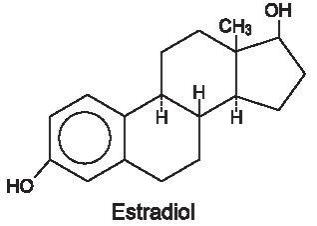
Alora consists of three layers. Proceeding from the polyethylene backing film as shown in the cross-sectional view below, the drug in adhesive matrix that is in contact with the skin consists of estradiol, USP and sorbitan monooleate dissolved in an acrylic adhesive matrix. The oversized polyester release liner protects the adhesive matrix during storage and is removed prior to application of the system to the skin.

Product meets USP Drug Release Test 3.
-
12
CLINICAL PHARMACOLOGY
12.1 Mechanism of Action
Endogenous and exogenous estrogens bind to estrogen receptors (estrogen receptor α or β) that are localized in target cells distributed throughout the body including the hypothalamus of the brain, reproductive tract, and bone. Reduced estrogen levels seen after menopause directly impact the structure and function of target tissues. In the brain, reductions in circulating estrogen result in changes to the production and release of neurochemicals that control thermal regulation, resulting in hot flushes or vasomotor symptoms. Reduced estrogen levels also lead to loss of vulvar and vaginal cells that produce and secrete fluids that address drying. In bone, cells responsible for bone formation are also sensitive to estrogen and reductions in estrogen result in a loss of bone deposition and density.
12.2 Pharmacodynamics
Generally, a serum concentration does not predict an individual woman’s therapeutic response to Alora nor her risk for adverse outcomes. Likewise, exposure comparisons across different estrogen products to infer efficacy or safety for the individual woman may not be valid.
12.3 Pharmacokinetics
The apparent mean (SD) serum half-life of estradiol is 1.75 ± 2.87 hours following Alora application.
Absorption
Estradiol is transported across intact skin and into the systemic circulation by a passive diffusion process, the rate of diffusion across the stratum corneum being the principal factor. Alora maintains continuous transport of estradiol to the surface of the skin over the 3 to 4 day dosing interval.
Direct measurement of total absorbed dose of estradiol through analysis of residual estradiol content of systems worn over a continuous 4-day interval during 251 separate occasions in 123 postmenopausal women demonstrated that the average daily dose absorbed from Alora was 0.003 ± 0.001 mg estradiol per cm2 active surface area. The nominal mean in vivo daily delivery rates of estradiol calculated from these data are 0.027 mg/day, 0.054 mg/day, 0.081 mg/day, and 0.11 mg/day for the 9 cm2, 18 cm2, 27 cm2, and 36 cm2 Alora, respectively.
In another study, 20 women also were treated with three consecutive doses of Alora 0.05 mg/day, Alora 0.075 mg/day and Alora 0.1 mg/day administered in a twice weekly regimen for three weeks to the abdominal application sites. Mean steady-state estradiol serum concentrations observed over the dosing interval are shown in Figure 1 and a summary of estradiol pharmacokinetic parameters is provided in Table 2.
Figure 1
Mean Steady-State Estradiol Serum Concentration During the Third Twice Weekly Dose of Alora 0.1 mg/day, Alora 0.075 mg/day, and Alora 0.05 mg/day in 20 Postmenopausal Women.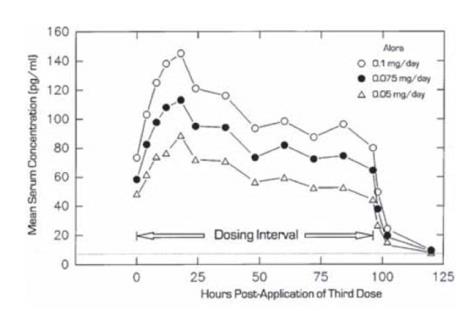
Table 2 Mean (SD) Pharmacokinetic Profile of Estradiol Over an 84-hour Dosing Interval following the Third Twice Weekly Dose of Alora 0.1 mg/day, Alora 0.075 mg/day, and Alora 0.05 mg/day in Postmenopausal Women.
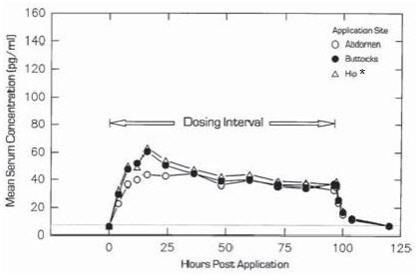
In a single-dose randomized crossover study conducted to compare the effect of site of Alora application, 31 postmenopausal women wore single Alora 0.05 mg/day for 4-day periods on the lower abdomen, upper quadrant of the buttocks, and outside aspect of the hip. The estradiol serum concentration profiles are shown in Figure 2 and a summary of estradiol pharmacokinetic parameters is provided in Table 3.
Figure 2
Mean Estradiol Serum Concentrations During a Single 4-Day Wearing of Alora 0.05 mg/day Applied by 31 Postmenopausal Women to the Lower Abdomen, Upper Quadrant of the Buttocks or Outer Aspect of the Hip.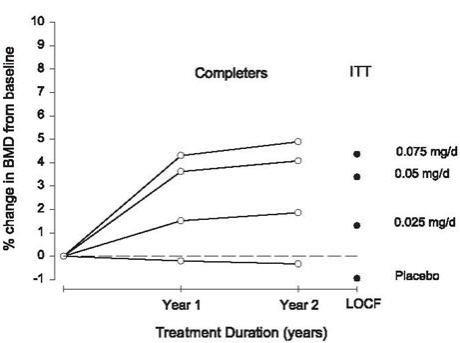
*Cmax and Cavg statistically different from abdomen
Table 3 Mean (SD) Pharmacokinetic Profile of Estradiol Following Application of Alora 0.05 mg/day in Postmenopausal Women to the Lower Abdomen, Upper Quadrant of the Buttocks or Outer Aspect of the Hip. Alora (mg/day) Application Site N Dosing Cmax (pg/mL) Cmin
(pg/mL)Cavg (pg/mL) CL
(L/hr)0.05 Abdomen 31 Single 53 (23) - 41 (18) 69 (22) Buttock 31 Single 67 (45) - 45 (21) 66 (23) Hip* 31 Single 69 (30) - 48 (17) 62 (18) *Cmax and Cavg statistically different from abdomen
Steady-state estradiol serum concentrations were measured in two well-controlled clinical trials in the treatment of menopausal symptoms of 3 month duration (Studies 1 and 2), and one trial in the prevention of postmenopausal osteoporosis of 2 year duration (Study 3).
Table 4 provides a summary of these data.
Table 4 Mean (SD) Steady-State Estradiol Serum Concentrations (pg/mL) in Clinical Trials of 3 Month (Trials 1 and 2) and 2 Year (Trial 3) Duration. Alora (mg/day) Study 1 Study 2 Study 3 0.025 - - 24.5 (12.4) 0.05 46.9 (38.5) 38.8 (38.0) 42.6 (23.7) 0.075 - - 56.7 (36.8) 0.1 99.2 (77.0) 97.0 (87.5) - In a 2-year, randomized, double-blind, placebo-controlled, prevention of postmenopausal osteoporosis study in 355 hysterectomized women, the average baseline-adjusted steady-state estradiol serum concentrations were 18.6 pg/mL (45 patients) for the 0.025 mg/day dose, 35.9 pg/mL (47 patients) for the 0.05 mg/day dose, and 50.1 pg/mL (46 patients) for the 0.075 mg/day dose. These values were linearly related and dose proportional.
Distribution
No specific investigation of the tissue distribution of estradiol absorbed from Alora in humans has been conducted. The distribution of exogenous estrogens is similar to that of endogenous estrogens. Estrogens are widely distributed in the body and are generally found in higher concentrations in the sex hormone target organs. Estrogens circulate in the blood largely bound to sex hormone binding globulin (SHBG) and albumin.
Metabolism
Exogenous estrogens are metabolized in the same manner as endogenous estrogens. Circulating estrogens exist in a dynamic equilibrium of metabolic interconversions. These transformations take place mainly in the liver. Estradiol is converted reversibly to estrone, and both can be converted to estriol, which is the major urinary metabolite. Estrogens also undergo enterohepatic recirculation via sulfate and glucuronide conjugation in the liver, biliary secretion of conjugates into the intestine, and hydrolysis in the gut followed by reabsorption. In postmenopausal women a significant portion of the circulating estrogens exists as sulfate conjugates, especially estrone sulfate, which serves as a circulating reservoir for the formation of more active estrogens.
Excretion
Estradiol, estrone and estriol are excreted in the urine along with glucuronide and sulfate conjugates.
12.6 Adhesion
The adhesion potential of Alora was evaluated in a randomized clinical trial involving 408 healthy postmenopausal women who wore placebo transdermal systems corresponding to the 18 cm2 size Alora. The placebo transdermal systems were applied twice weekly for 4 weeks on the lower quadrant of the abdomen (the lower abdomen, the upper quadrant of the buttocks or outer aspect of the hip are the approved recommended application sites). Subjects were instructed not to do strenuous activities, take baths, use hot tubs or swim. In 968 observations, there was a partial or complete adhesion rate of approximately 97%. The total detachment rate was approximately 3%. Adhesion potentials of the 9 cm2, 27 cm2 and 36 cm2 sizes of Alora have not been studied.
- 13 NONCLINICAL TOXICOLOGY
-
14
CLINICAL STUDIES
14.1 Effects on Vasomotor Symptoms in Postmenopausal Women
Efficacy of Alora was evaluated in a double blind/double dummy, randomized, parallel group, placebo-controlled trial (Trial 1) involving a total of 268 postmenopausal women over a 12-week dosing period. In this study, the population was primarily Caucasian (88%), and had a mean age of 50.9 years (range 31-70 years). Only women having estradiol and FSH serum concentrations in the postmenopausal range and who exhibited a weekly average of at least 60 moderate to severe hot flushes during the screening period were enrolled in the studies.
Women received Alora, 0.05 mg/day and a placebo transdermal system, or Alora, 0.1 mg/day and a placebo transdermal system, or two placebo transdermal systems, administered twice weekly over a 12-week duration. Measures of efficacy included mean reduction in weekly number of moderate to severe vasomotor symptoms when compared to the mean baseline average determined during a 2-week pre-dosing screening period. Alora was shown to be statistically significantly superior to placebo at Weeks 4 and 12 for relief of both the frequency (see Table 5) and severity of vasomotor symptoms.
Table 5 Mean Change from Baseline in the Frequency of Moderate to Severe Vasomotor Symptoms in Postmenopausal Women, treated with Alora Compared to Placebo (ITT). Mean Change from Baseline
Week of TherapyAlora 0.05 mg/day
N = 87
Baseline = 90Alora 0.1 mg/day
N = 91
Baseline = 85Placebo
N = 90
Baseline = 924* -57 -70 -45 8 -65 -77 -49 12* -68 -79 -54 * Indicates statistically significant differences between both strengths of Alora and placebo using an ANCOVA model adjusting for baseline. 14.2 Effects on Vulvar and Vaginal Atrophy in Postmenopausal Women
Vaginal cytology was obtained pre-dosing and at last visit in 54 women treated with Alora, 0.05 mg/day, in 45 women treated with Alora, 0.1 mg/day, and in 46 women who received placebo transdermal system (Trial 2). Superficial cells increased by a mean of 18.7%, 23.7%, and 8.7% for Alora 0.05 mg/day, Alora, 0.1 mg/day, and placebo transdermal system, respectively. Corresponding reductions in basal/parabasal and intermediate cells were also observed.
14.3 Effects on Bone Mineral Density
Lumbar spine bone mineral density (BMD) was measured by DEXA in a 2-year, randomized, multi-center, double-blind, placebo-controlled trial (Trial 3) in 355 hysterectomized, non-osteoporotic women (i.e., T-scores > -2.5). Eighty-six percent of the women were Caucasian, the mean age was 53.2 years (range 26 to 69), and the average number of years since menopause (natural or surgical) was not determined. Three Alora dosage strengths (0.025 mg/day, 0.05 mg/day, and 0.075 mg/day) were compared to placebo in terms of the % change in BMD from baseline to Year 2. The systems were applied every 3 or 4 days on alternate sides of the lower abdomen. All women received 1000 mg of oral elemental calcium daily. The average baseline lumbar spine T-score was -0.64 (range -2.7 to 3.8). The % changes in BMD from baseline are illustrated in Figure 3.
Figure 3
Mean % Change from Baseline at 1 and 2 Years in the Bone Marrow Density of Non-Osteoporotic Women, Following Therapy with Alora, 0.025, 0.05, and 0.075 mg/day and Placebo [Completer and Intent-to-Treat Populations with Last Observation Carried Forward (LOCF)].![Figure 3
Mean % Change from Baseline at 1 and 2 Years in the Bone Marrow Density of Non-Osteoporotic Women, Following Therapy with Alora, 0.025, 0.05, and 0.075 mg/day and Placebo [Completer and Intent-to-Treat Populations with Last Observation Carried Forward (LOCF)].](https://fda.report/DailyMed/a0d4f0b8-5dcc-4ffe-9590-0203e869622f/alora-06.jpg)
A total of 196 women (44 – 0.025 mg/d, 49 – 0.05 mg/d, 45 – 0.075 mg/d, and 58 – placebo) were included in the completer population compared with 258 patients (59 – 0.025 mg/d, 64 – 0.05 mg/d, 63 – 0.075 mg/d, and 72 – placebo) in the intent-to-treat, last observation carried forward population.
All Alora doses were statistically significantly superior to placebo for the primary endpoint, percent change in BMD from baseline. The mean 2-year (LOCF) percent changes in BMD for the 0.025 mg/d, 0.05 mg/d, 0.075 mg/d Alora dosage strengths, and placebo were 1.45%, 3.39%, 4.24%, and –0.80% respectively.
14.4 Women’s Health Initiative Studies
The WHI enrolled a total of 27,000 predominantly healthy postmenopausal women in two substudies to assess the risks and benefits of daily oral CE (0.625 mg)-alone or in combination with MPA (2.5 mg) compared to placebo in the prevention of certain chronic diseases. The primary endpoint was the incidence of CHD (defined as nonfatal MI, silent MI and CHD death), with invasive breast cancer as the primary adverse outcome studied. A “global index” included the earliest occurrence of CHD, invasive breast cancer, stroke, PE, endometrial cancer (only in the CE plus MPA substudy), colorectal cancer, hip fracture, or death due to other cause. The substudies did not evaluate the effects of CE-alone or CE plus MPA on menopausal symptoms.
WHI Estrogen-Alone Substudy
The WHI estrogen-alone substudy was stopped early because an increased risk of stroke was observed, and it was deemed that no further information would be obtained regarding the risk and benefits of estrogen-alone in predetermined primary endpoints.
Results of the estrogen-alone substudy, which included 10,739 women (average 63 years of age, range 50 to 79: 75.3 percent White, 15.1 percent Black, 6.1 percent Hispanic, 3.6 percent Other) after an average follow-up of 7.1 years, are presented in Table 6.
Table 6. Relative and Absolute Risk Seen in the Estrogen-Alone Substudy of WHIa Event Relative Risk
CE vs. Placebo
(95% nCIb)CE
n = 5,310Placebo
n = 5,429Absolute Risk per 10,000
Women-yearsCHD eventsc 0.95 (0.78-1.16) 54 57 Non-fatal MIc 0.91 (0.73-1.14) 40 43 CHD deathc 1.01 (0.71-1.43) 16 16 All strokesc 1.33 (1.05-1.68) 45 33 Ischemic strokec 1.55 (1.19-2.01) 38 25 Deep vein thrombosisc,d 1.47 (1.06-2.06) 23 15 Pulmonary embolismc 1.37 (0.9-2.07) 14 10 Invasive breast cancerc 0.80 (0.62-1.04) 28 34 Colorectal cancerc 1.08 (0.75-1.55) 17 16 Hip fracturec 0.65 (0.45-0.94) 12 19 Vertebral fracturesc,d 0.64 (0.44-0.93) 11 18 Lower arm/wrist fracturesc,d 0.58 (0.47-0.72) 35 59 Total fracturesc,d 0.71 (0.64-0.80) 144 197 Death due to other causese,f 1.08 (0.88-1.32) 53 50 Overall mortalityc,d 1.04 (0.88-1.22) 79 75 Global Indexg 1.02 (0.92-1.13) 206 201 a) Adapted from numerous WHI publications. WHI publications can be viewed at www.nhlbi.nih.gov/whi.
b) Nominal confidence intervals unadjusted for multiple looks and multiple comparisons.
c) Results are based on centrally adjudicated data for an average follow-up of 7.1 years.
d) Not included in “global index”.
e) Results are based on an average follow-up of 6.8 years.
f) All deaths, except from breast or colorectal cancer, definite or probable CHD, PE or cerebrovascular disease.
g) A subset of the events was combined in a "global index", defined as the earliest occurrence of CHD events, invasive breast cancer, stroke, pulmonary embolism, endometrial cancer, colorectal cancer, hip fracture, or death due to other causes.For those outcomes included in the WHI "global index" that reached statistical significance, the absolute excess risks per 10,000 women-years in the group treated with CE-alone was 12 more strokes, while the absolute risk reduction per 10,000 women-years was 7 fewer hip fractures.9 The absolute excess risk of events included in the "global index" was a non-significant 5 events per 10,000 women-years. There was no difference between the groups in terms of all-cause mortality.
No overall difference for primary CHD events (nonfatal MI, silent MI and CHD death) and invasive breast cancer incidence in women receiving CE-alone compared with placebo was reported in final centrally adjudicated results from the estrogen-alone substudy, after an average follow-up of 7.1 years. See Table 6.
Centrally adjudicated results for stroke events from the estrogen-alone substudy, after an average follow-up of 7.1 years, reported no significant difference in the distribution of stroke subtype and severity, including fatal strokes, in women receiving estrogen-alone compared to placebo. Estrogen-alone increased the risk of ischemic stroke, and this excess risk was present in all subgroups of women examined.10
Timing of initiation of estrogen-alone therapy relative to the start of menopause may affect the overall risk-benefit profile. The WHI estrogen-alone substudy stratified by age showed in women 50 to 59 years of age a non-significant trend toward reduced risk for CHD [hazard ratio (HR) 0.63 (95 percent CI, 0.36-1.09)] and overall mortality [HR 0.71 (95 percent CI, 0.46-1.11)].
WHI Estrogen Plus Progestin Substudy
The WHI estrogen plus progestin substudy was stopped early. According to the predefined stopping rule, after an average follow-up of 5.6 years of treatment, the increased risk of invasive breast cancer and cardiovascular events exceeded the specified benefits included in the “global index.” The absolute excess risk of events included in the “global index” was 19 per 10,000 women-years.
For those outcomes included in the WHI “global index” that reached statistical significance after 5.6 years of follow-up, the absolute excess risks per 10,000 women-years in the group treated with CE plus MPA were 7 more CHD events, 8 more strokes, 10 more PEs, and 8 more invasive breast cancers, while the absolute risk reduction per 10,000 women-years were 6 fewer colorectal cancers and 5 fewer hip fractures.
Results of the CE plus MPA substudy, which included 16,608 women (average age of 63 years, range 50 to 79; 83.9% White, 6.8% Black, and 5.4% Hispanic, 3.9% Other), are presented in Table 7.
Table 7 Relative and Absolute Risk Seen in the Estrogen Plus Progestin Substudy of WHI at an Average of 5.6 Years a,b Event Relative Risk
CE/MPA vs. placebo
(95% nCIc)CE/MPA
n = 8,506Placebo
n = 8,102Absolute Risk per 10,000 Women-years CHD events 1.23 (0.99-1.53) 41 34 Non-fatal MI 1.28 (1.00-1.63) 31 25 CHD death 1.10 (0.70-1.75) 8 8 All strokes 1.31 (1.03-1.68) 33 25 Ischemic stroke 1.44 (1.09-1.90) 26 18 Deep vein thrombosisd 1.95 (1.43-2.67) 26 13 Pulmonary embolism 2.13 (1.45-3.11) 18 8 Invasive breast cancere 1.24 (1.01-1.54) 41 33 Colorectal cancer 0.61 (0.42-0.87) 10 16 Endometrial cancerd 0.81 (0.48-1.36) 6 7 Cervical cancerd 1.44 (0.47-4.42) 2 1 Hip fracture 0.67 (0.47-0.96) 11 16 Vertebral fracturesd 0.65 (0.46-0.92) 11 17 Lower arm/wrist fracturesd 0.71 (0.59-0.85) 44 62 Total fracturesd 0.76 (0.69-0.83) 152 199 Overall mortalityf 1.00 (0.83-1.19) 52 52 Global Indexg 1.13 (1.02-1.25) 184 165 a) Adapted from numerous WHI publications. WHI publications can be viewed at www.nhlbi.nih.gov/whi.
b) Results are based on centrally adjudicated data.
c) Nominal confidence intervals unadjusted for multiple looks and multiple comparisons.
d) Not included in “global index”.
e) Includes metastatic and non-metastatic breast cancer, with the exception of in situ breast cancer.
f) All deaths, except from breast or colorectal cancer, definite or probable CHD, PE or cerebrovascular disease.
g) A subset of the events was combined in a "global index", defined as the earliest occurrence of CHD events, invasive breast cancer, stroke, pulmonary embolism, endometrial cancer, colorectal cancer, hip fracture, or death due to other causes.Timing of initiation of estrogen plus progestin therapy relative to the start of menopause may affect the overall risk benefit profile. The WHI estrogen plus progestin substudy stratified by age showed in women 50 to 59 years of age, a non-significant trend toward reduced risk for overall mortality [HR 0.69 (95 percent CI, 0.44-1.07)].
14.5 Women’s Health Initiative Memory Study
The WHIMS estrogen-alone ancillary study of WHI enrolled 2,947 predominantly healthy hysterectomized postmenopausal women 65 to 79 years of age (45 percent were 65 to 69 years of age; 36 percent were 70 to 74 years of age; 19 percent were 75 years of age and older) to evaluate the effects of daily CE (0.625 mg)-alone on the incidence of probable dementia (primary outcome) compared to placebo.
After an average follow-up of 5.2 years, the relative risk of probable dementia for CE-alone versus placebo was 1.49 (95 percent CI, 0.83-2.66). The absolute risk of probable dementia for CE-alone versus placebo was 37 versus 25 cases per 10,000 women-years. Probable dementia as defined in the study included Alzheimer’s disease (AD), vascular dementia (VaD) and mixed types (having features of both AD and VaD). The most common classification of probable dementia in the treatment group and the placebo group was AD. Since the ancillary study was conducted in women 65 to 79 years of age, it is unknown whether these findings apply to younger postmenopausal women [see Warnings and Precautions (5.3), and Use in Specific Populations (8.5)].
The WHIMS estrogen plus progestin ancillary study enrolled 4,532 predominantly healthy postmenopausal women 65 years of age and older (47 percent were 65 to 69 years of age; 35 percent were 70 to 74 years of age; and 18 percent were 75 years of age and older) to evaluate the effects of daily CE (0.625 mg) plus MPA (2.5 mg) on the incidence of probable dementia (primary outcome) compared to placebo.
After an average follow-up of 4 years, the relative risk of probable dementia for CE plus MPA versus placebo was 2.05 (95 percent CI, 1.21-3.48). The absolute risk of probable dementia for CE plus MPA versus placebo was 45 versus 22 cases per 10,000 women-years. Probable dementia as defined in the study included AD, VaD and mixed types (having features of both AD and VaD). The most common classification of probable dementia in the treatment group and the placebo group was AD. Since the ancillary study was conducted in women 65 to 79 years of age, it is unknown whether these findings apply to younger postmenopausal women [see Warnings and Precautions (5.3), and Use in Specific Populations (8.5)].
When data from the two populations were pooled as planned in the WHIMS protocol, the reported overall relative risk for probable dementia was 1.76 (95 percent CI, 1.19-2.60). Differences between groups became apparent in the first year of treatment. It is unknown whether these findings apply to younger postmenopausal women [see Warnings and Precautions (5.3), and Use in Specific Populations (8.5)].
-
15
REFERENCES
- Rossouw JE, et al. Postmenopausal Hormone Therapy and Risk of Cardiovascular Disease by Age and Years Since Menopause. JAMA. 2007;297:1465-1477.
- Hsia J, et al. Conjugated Equine Estrogens and Coronary Heart Disease. Arch Int Med. 2006;166:357-365.
- Curb JD, et al. Venous Thrombosis and Conjugated Equine Estrogen in Women Without a Uterus. Arch Int Med. 2006;166:772-780.
- Cushman M, et al. Estrogen Plus Progestin and Risk of Venous Thrombosis. JAMA. 2004;292:1573-1580.
- Stefanick ML, et al. Effects of Conjugated Equine Estrogens on Breast Cancer and Mammography Screening in Postmenopausal Women With Hysterectomy. JAMA. 2006;295:1647-1657.
- Chlebowski RT, et al. Influence of Estrogen Plus Progestin on Breast Cancer and Mammography in Healthy Postmenopausal Women. JAMA. 2003;289:3234-3253.
- Anderson GL, et al. Effects of Estrogen Plus Progestin on Gynecologic Cancers and Associated Diagnostic Procedures. JAMA. 2003;290:1739-1748.
- Shumaker SA, et al. Conjugated Equine Estrogens and Incidence of Probable Dementia and Mild Cognitive Impairment in Postmenopausal Women. JAMA. 2004;291:2947-2958.
- Jackson RD, et al. Effects of Conjugated Equine Estrogen on Risk of Fracture and BMD in Postmenopausal Women With Hysterectomy: Results From the Women’s Health Initiative Randomized Trial. J Bone Miner Res. 2006;21:817-828.
- Hendrix, SL, et al. Effects of Conjugated Equine Estrogen on Stroke in the Women’s Health Initiative. Circulation. 2006;113:2425-2434.
- Rossouw JE, et al. Postmenopausal Hormone Therapy and Risk of Cardiovascular Disease by Age and Years Since Menopause. JAMA. 2007;297:1465-1477.
-
16
HOW SUPPLIED/STORAGE AND HANDLING
16.1 How Supplied
Alora 0.025 mg. Each 9 cm2 system contains 0.77 mg of estradiol for nominal delivery of 0.025 mg of estradiol per day over a 3 to 4-day interval.
- NDC: 0023-5885-12
Alora 0.05 mg. Each 18 cm2 system contains 1.5 mg of estradiol for nominal delivery of 0.05 mg of estradiol per day over a 3 to 4-day interval.
- NDC: 0023-5886-15
Alora 0.075 mg. Each 27 cm2 system contains 2.3 mg of estradiol for nominal delivery of 0.075 mg of estradiol per day over a 3 to 4-day interval.
- NDC: 0023-5887-17
Alora 0.1 mg. Each 36 cm2 system contains 3.1 mg of estradiol for nominal delivery of 0.1 mg of estradiol per day over a 3 to 4-day interval.
- NDC: 0023-5888-11
16.2 Storage and Handling
Store at 20-25°C (68-77°F). [See USP controlled room temperature.]
Do not store unpouched. Apply immediately upon removal from the protective pouch. Discard used Alora in household trash in a manner that prevents accidental application or ingestion by children, pets, or others.
Keep out of reach of children.
-
17
PATIENT COUNSELING INFORMATION
Advise the patient to read FDA-approved patient labeling (Patient Information and Instructions for Use).
Vaginal Bleeding
Inform women to report any vaginal bleeding to their healthcare provider as soon as possible [see Warnings and Precautions (5.2)].
Possible Serious Adverse Reactions with Estrogen-Alone Therapy
Inform postmenopausal women of possible serious adverse reactions of estrogen-alone therapy including cardiovascular disorders, malignant neoplasms, and possible dementia [see Warning and Precautions (5.1, 5.2, 5.3)].
Possible Less Serious but Common Adverse Reactions with Estrogen-Alone Therapy
Inform postmenopausal women of possible less serious but common adverse reactions of estrogen-alone therapy such as headaches, breast pain and tenderness, nausea and vomiting.
For all medical inquiries contact:
Allergan Medical Communications1-800-678-1605
Distributed By:
Allergan USA, Inc.Madison, NJ 07940
03/2020 Alora® is a registered trademark of Allergan Sales, LLC.
©2020 Allergan. All rights reserved.
V2.0USPI5885
-
PATIENT PACKAGE INSERT
Patient Information
ALORA (ah-LORE-ah)
(estradiol transdermal system)Read this Patient Information before you start using ALORA and each time you get a refill. There may be new information. This information does not take the place of talking to your healthcare provider about your menopausal symptoms or your treatment. What is the most important information I should know about ALORA (an estrogen hormone)? - Using estrogen-alone may increase your chance of getting cancer of the uterus (womb).
- Report any unusual vaginal bleeding right away while you are using the ALORA. Vaginal bleeding after menopause may be a warning sign of cancer of the uterus (womb). Your healthcare provider should check any unusual vaginal bleeding to find out the cause.
- Do not use estrogen-alone to prevent heart disease, heart attacks, strokes, or dementia (decline in brain function).
- Using estrogen-alone may increase your chances of getting strokes or blood clots.
- Using estrogen-alone may increase your chance of getting dementia, based on a study of women age 65 years of age or older.
- Do not use estrogens with progestins to prevent heart disease, heart attacks, strokes or dementia.
- Using estrogens with progestins may increase your chances of getting heart attacks, strokes, breast cancer, or blood clots.
- Using estrogens with progestins may increase your chance of getting dementia, based on a study of women age 65 years of age or older.
- Only one estrogen-alone product and dose has been shown to increase your chances of getting strokes, blood clots, and dementia. Only one estrogen with progestin product and dose has been shown to increase your chances of getting heart attacks, strokes, breast cancer, blood clots, and dementia.
Because other products and doses have not been studied in the same way, it is not known how the use of ALORA. will affect your chances of these conditions. You and your healthcare provider should talk regularly about whether you still need treatment with the ALORA.
What is ALORA?
ALORA is a prescription medicine patch (transdermal system) that contains an estrogen hormone.What is ALORA used for?
ALORA is used after menopause to:
-
Reduce moderate or severe hot flashes.
Estrogens are hormones made by a woman’s ovaries. The ovaries normally stop making estrogens when a woman is between 45 and 55 years old. This drop in body estrogen levels causes the “change of life” or menopause (the end of monthly menstrual periods). Sometimes, both ovaries are removed during an operation before natural menopause takes place. The sudden drop in estrogen levels causes “surgical menopause.”
When estrogen levels begin dropping, some women develop very uncomfortable symptoms, such as feelings of warmth in the face, neck, and chest, or sudden intense episodes of heat and sweating (“hot flashes” or “hot flushes”). In some women the symptoms are mild and they will not need estrogens. In other women, symptoms can be more severe.
-
Treat moderate to severe menopausal changes in and around the vagina.
You and your healthcare provider should talk regularly about whether you still need treatment with ALORA to control these problems. If you use ALORA only to treat your menopausal changes in and around your vagina, talk with your healthcare provider about whether a topical vaginal product would be better for you.
-
Treat certain conditions in which a young woman’s ovaries do not produce enough estrogen naturally.
-
Help reduce your chances of getting osteoporosis (thin weak bones).
If you use ALORA only to prevent osteoporosis due to menopause, talk with your healthcare provider about whether a different treatment or medicine without estrogens might be better for you. You and your healthcare provider should talk regularly about whether you still need treatment with ALORA.
Who Should Not Use ALORA? Do not start using ALORA if you: -
have unusual vaginal bleeding.
Vaginal bleeding after menopause may be a warning sign of cancer of the uterus (womb). Your healthcare provider should check any usual vaginal bleeding to find out the cause.
-
have been diagnosed with a bleeding disorder.
-
currently have or have had certain cancers.
Estrogens may increase the chance of certain types of cancer, including cancer of the breast or uterus. If you have or have had cancer, talk to your healthcare provider about whether you should use ALORA.
-
had a stroke or heart attack.
-
currently have or have had blood clots.
-
currently have or have had liver problems.
- are allergic to ALORA or any of the ingredients in it. See the list of ingredients in ALORA at the end of this leaflet.
Before you use ALORA, tell your healthcare provider about all of your medical conditions, including if you:
-
have any unusual vaginal bleeding
Vaginal bleeding after menopause may be a warning sign of cancer of the uterus (womb). Your healthcare provider should check any usual vaginal bleeding to find out the cause.
-
have any other medical conditions that may become worse while you are using Alora
Your healthcare provider may need to check you more carefully if you have certain conditions, such as asthma (wheezing); epilepsy (seizures); diabetes; migraine; endometriosis; lupus; problems with your heart, liver, thyroid, kidneys; or have high calcium levels in your blood.
-
are going to have surgery or will be on bed rest.
Your healthcare provider will let you know if you need to stop using ALORA.
-
are breastfeeding.
The hormone in ALORA can pass into your breast milk.
How should I use ALORA?
For detailed instructions, see the step-by-step instructions for using ALORA at the end of this Patient Information.
- Use ALORA exactly as your healthcare provider tells you to use it.
- ALORA is for skin use only.
- Apply a new patch 2 times each week.
- Apply your ALORA patch to a clean, dry area on your lower abdomen the first time. After the first time, apply your ALORA patch to a different area of your lower abdomen, upper buttocks, or the outer part of the hip. This area must be clean, dry, and free of powder, oil, or lotion for your patch to stick to your skin.
-
Do not use the same application site 2 times in the same week.
-
Do not apply to an area with cuts, rashes, or any other skin problems.
-
Do not apply ALORA to your breasts or any other parts of your body.
- Do not stop using ALORA without first talking to your healthcare provider.
What Are the Possible Side Effects of ALORA?
Side effects are grouped by how serious they are and how often they happen when you are treated. Serious, but less common side effects include:
- heart attack
stroke
- blood clots
dementia
- breast cancer
cancer of the lining of the uterus (womb)
- cancer of the ovary
high or low blood calcium
- gallbladder disease visual abnormalities
- high blood pressure
high levels of fat (triglycerides) in your blood
- liver problems
changes in your thyroid hormone levels
- cancer change of endometriosis
enlargement of benign tumors of the uterus (“fibroids”)
- worsening swelling face or tongue (angioedema)
in women who have a history of angioedema
- new breast lumps
- unusual vaginal bleeding
- changes in vision or speech
- sudden new severe headaches
- severe pains in your chest or legs with or without shortness of breath, weakness and fatigue
- abdominal pain
back pain
- breast pain
breast enlargement
- fungal infection
cysts
- nausea
stomach/intestines irritation
- indigestion
dizziness
- itching
rash
- migraine
vaginal discharge
- facial and body hair growth
Call your doctor for medical advice about side effects. You may report side effects to Allergan at 1-800-678-1605 or to FDA at 1-800-FDA-1088.How should I store ALORA?
- Store ALORA at room temperature between 68°F to 77°F (20°C to 25°C).
- Do not store ALORA patches outside of their pouches. Apply the patch as soon as you take it out of the protective pouch.
What Can I Do to Lower My Chances of Getting a Serious Side Effect with ALORA? - Talk with your healthcare provider regularly about whether you should continue using ALORA.
- If you have a uterus, talk to your healthcare provider about whether the addition of a progestin is right for you. In general, the addition of a progestin is recommended for women with a uterus to reduce the chance of getting cancer of the uterus.
- See your healthcare provider right away if you get vaginal bleeding while using ALORA.
- Have a pelvic exam, breast exam and mammogram (breast X-ray) every year unless your healthcare provider tells you something else. If members of your family have had breast cancer or if you have ever had breast lumps or an abnormal mammogram, you may need to have breast exams more often.
- If you have high blood pressure, high cholesterol (fat in the blood), diabetes, are overweight, or if you use tobacco, you may have higher chances for getting heart disease. Ask your healthcare provider for ways to lower your chances for getting heart disease.
General information about the safe and effective use of ALORA.
Medicines are sometimes prescribed for purposes other than those listed in Patient Information leaflets. Do not use ALORA for a condition for which it was not prescribed. Do not give ALORA to other people, even if they have the same symptoms that you have. It may harm them.
You can ask your pharmacist or healthcare provider for information about ALORA that is written for health professionals.What are the ingredients in ALORA? - Using estrogen-alone may increase your chance of getting cancer of the uterus (womb).
-
INSTRUCTIONS FOR USE
INSTRUCTIONS FOR USE
ALORA (ah-LORE-ah)
(estradiol transdermal system)Read this Instructions for Use before you start using ALORA and each time you get a refill. There may be new information. This information does not take the place of talking to your healthcare provider about your menopausal symptoms or your treatment.
Step 1. Choose your schedule for applying ALORA.
- You will apply ALORA 2 times each week.
- You should use one of the schedules on the box of patches (See Figure A).
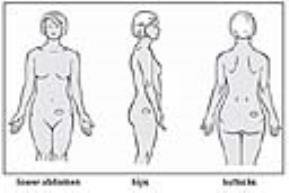
Figure A
- For example, if you apply your first patch on Sunday, take that patch off on Wednesday and put on a new one. Stay on this schedule as long as you use ALORA. To help remind yourself, mark the schedule on the box of patches. Put a check next to the first day you apply the patch. When you change your patch, do not put the new one in the same place. To help reduce the chance of skin redness or irritation, wait at least 1 week before you reuse a skin area.
Step 2. Before you apply the patch make sure the skin area is:
- freshly washed, but dry and cool (wait a few minutes after taking a hot bath or shower).
- free of body powder, oil, or lotion.
- free of cuts, rashes, or any other skin problem.
Step 3. Choose a skin area to apply the patch
-
Place the patch on the lower abdomen (below the panty line) when you first start using ALORA.
- As you get used to applying ALORA you may want to try the outer part of the hips or upper buttocks to see which area works best for you. (See Figure B).
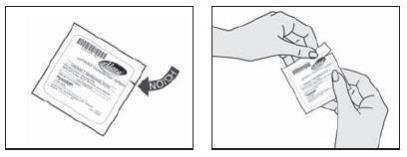
Figure B
-
Do not apply ALORA to your breasts or any other parts of your body.
- Avoid the waistline since clothing and belts may cause the patch to be rubbed off.
Step 4. How to apply the patch
-
Do not open the pouch that contains the patch until you are ready to apply it.
- Open the pouch that contains the patch by tearing off the edge. Do not cut the pouch with scissors. This may damage the patch inside (See Figure C).
- Pull the patch out.

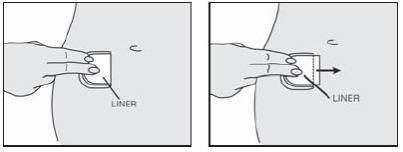
Figure C
Apply one half of the patch to your skin.
- A clear, protective liner covers the sticky side of the patch. This is the side you will place on your skin.
- Remove half of the liner. Bend the patch in half. Then grab the clear straight edge of the liner and pull this half of the liner off.
- Without touching the sticky surface, apply one half of the patch to your skin.
- Press the sticky half of the patch onto your skin (If you touch the sticky surface, the patch may not stay on well) (See Figure D).
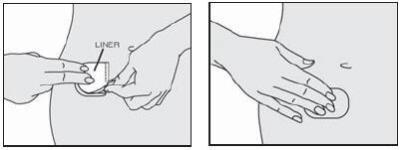
Figure D
- Press for at least 10 seconds to make sure the patch will stay in place.
- Pull off the other half of the protective liner.
Apply the second half of the patch to your skin.
- Bend the patch back over itself. Press down on the liner firmly. Push the liner forward a little to loosen the edge (See Figure E).

Figure E
- Grab the loose edge at either corner and peel off the second piece of the liner. Try not to touch the sticky surface of the patch (See Figure F).
- Press the entire patch firmly onto the skin with your fingertips for at least 10 seconds (See Figure F)
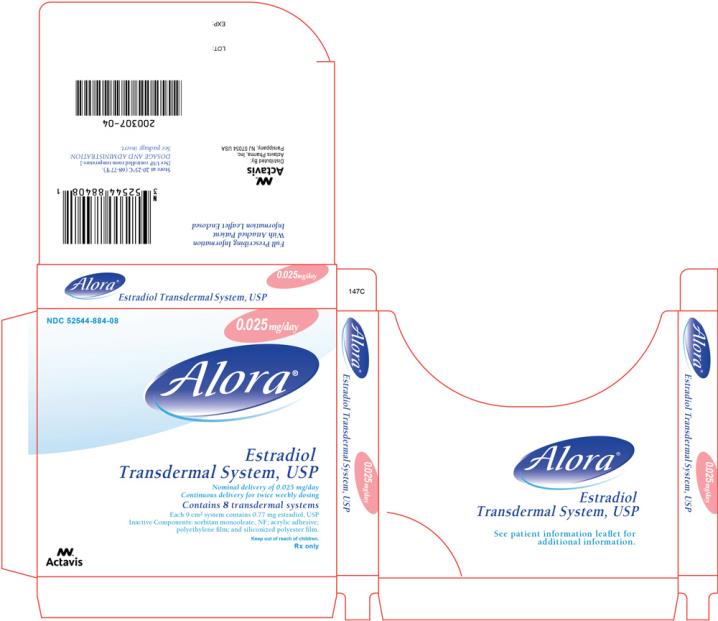
Figure F
To help the patch stay in place:
- Try not to disturb the patch while putting on and removing clothes. It may help to place the patch where your underwear will cover it at all times.
- Be careful while changing clothes, washing or drying off, so that you do not catch the patch with your clothes or the towel.
- Try different sites on the lower abdomen, outer part of the hips, or upper buttocks area to see what works well with your body and your clothing.
- If the patch starts to lift, press it back in place.
- If your patch falls off reapply it. If you cannot reapply the patch, apply a new patch to another area and continue to follow your original placement schedule.
Step 5. Removing the patch
-
Take off the old patch.
- The skin under the old patch may look discolored, but this should fade away soon. In some cases, the skin may itch or look red. This may last a few hours to a few days. It should go away by itself. If it bothers you a lot or lasts longer than a few days, call your healthcare provider.
Step 6. Throwing away your used patches
- Used patches still contain estrogen. To throw away the patch, fold the sticky sides of the patch together, place in a sturdy child-proof container, and place the container in the trash. Used patches should not be flushed in the toilet.
Replacing your patches:
-
Replace your patch 2 times each week, on the 2 days you have chosen. Until it becomes a habit, try:
- Marking your schedule on the back of the box of patches
- Marking the days on your calendar
- Marking your schedule on the back of the box of patches
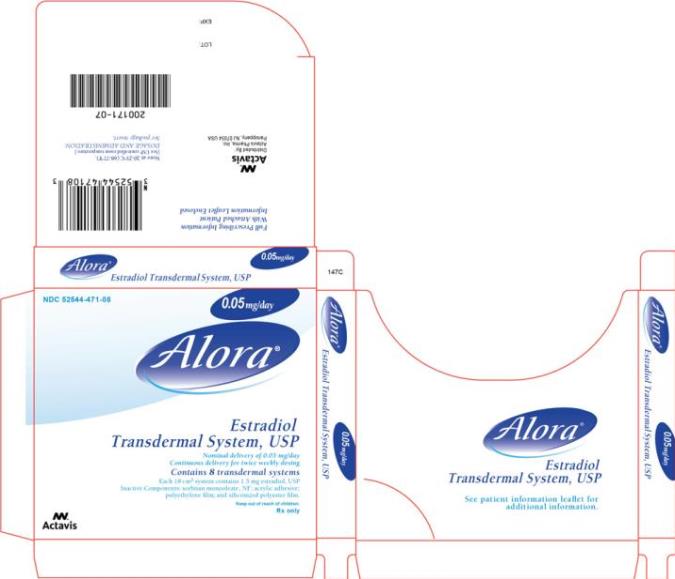
○ Link the days you change your patch to other things that always happen on those days such as an exercise class or meeting.
-
Keep working with your healthcare provider, pharmacist, or other healthcare professional.
- Ask questions and talk about your concerns.
-
Do not stop using the patch on your own. Remember, it may take a little time and some experience to get use to using an ALORA patch.
- Estrogens should be used only as long as needed. Start with the lowest dose and talk to your healthcare provider about how well that dose is working for you. You and your healthcare provider should talk regularly (for example, every 3 to 6 months) about whether you still need treatment with ALORA.
How should I store ALORA?
- Store ALORA at room temperature between 68°F to 77°F (20°C to 25°C).
- Do not store ALORA patches outside of their pouches. Apply the patch as soon as you take it out of the protective pouch.
Keep ALORA patches and all medicines out of the reach of children.
Distributed By:
Allergan USA, Inc.
Madison, NJ 07940Rev. 03/2020
- You will apply ALORA 2 times each week.
-
PRINCIPAL DISPLAY PANEL
Principal Display Panel
Alora® Estradiol Transdermal System, USP
NDC: 52544-884-08
Carton of 8 systems 0.025 mg/day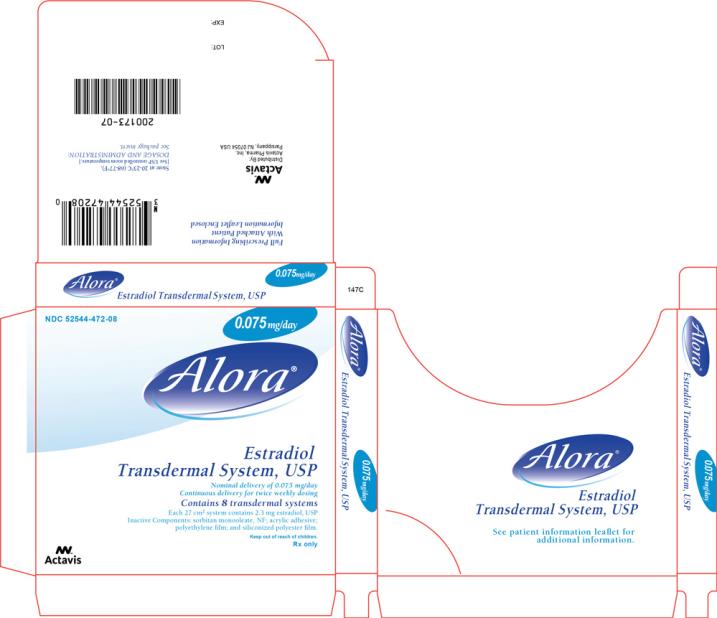
-
PRINCIPAL DISPLAY PANEL
Principal Display Panel
Alora® Estradiol Transdermal System, USP
NDC: 52544-471-08
Carton of 8 systems 0.05 mg/day
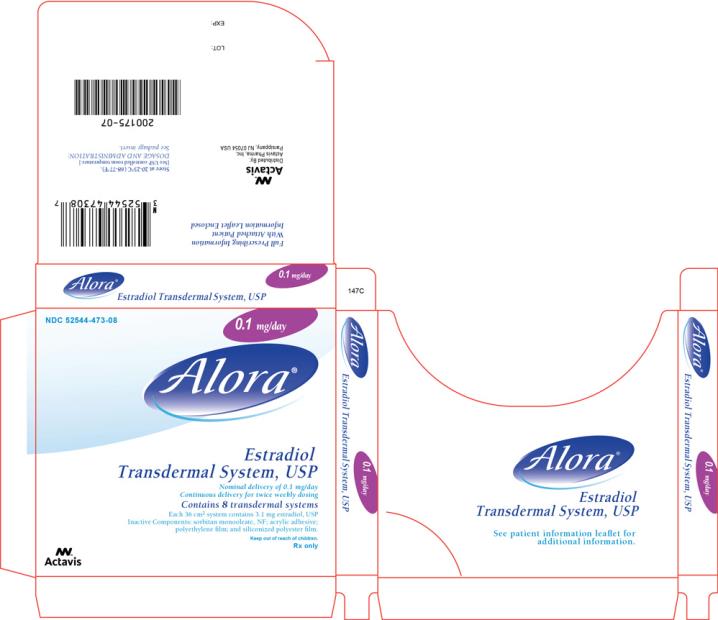
-
PRINCIPAL DISPLAY PANEL
Principal Display Panel
Alora® Estradiol Transdermal System, USP
NDC: 52544-472-08
Carton of 8 systems 0.075 mg/day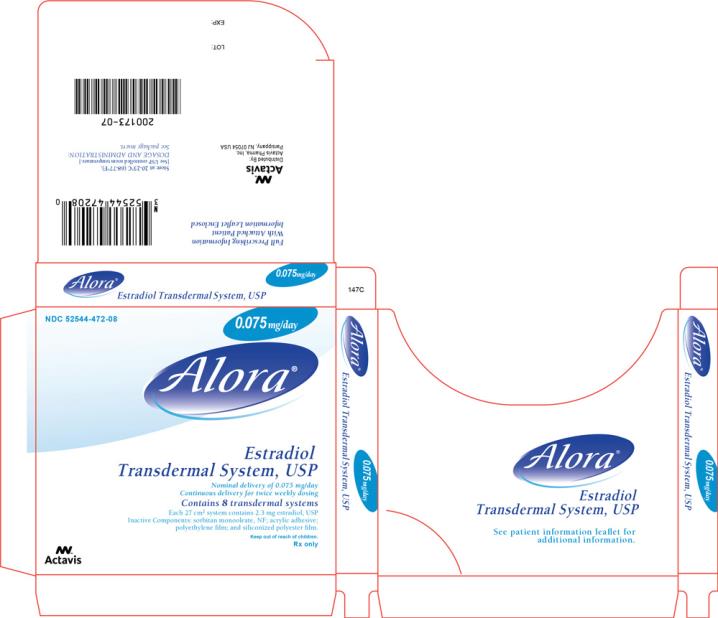
-
PRINCIPAL DISPLAY PANEL
Principal Display Panel
Alora® Estradiol Transdermal System, USP
NDC: 52544-473-08
Carton of 8 systems 0.1 mg/day
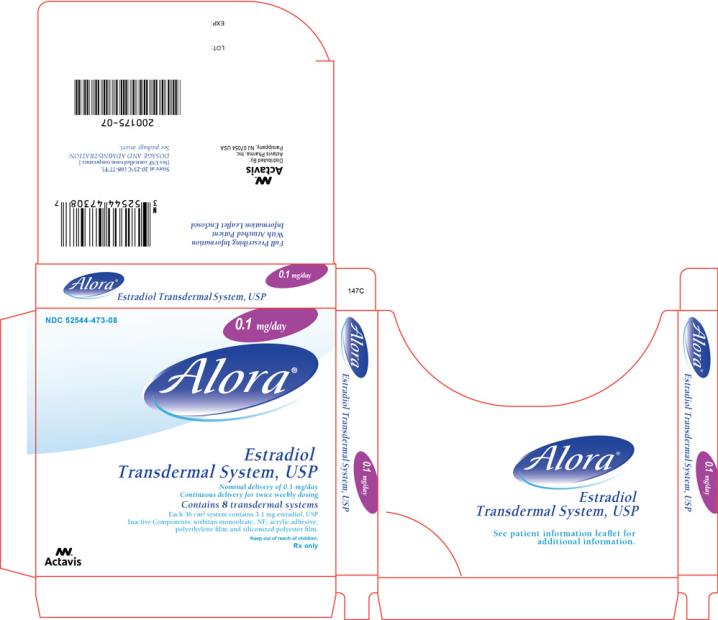
-
INGREDIENTS AND APPEARANCE
ALORA
estradiol patchProduct Information Product Type HUMAN PRESCRIPTION DRUG Item Code (Source) NDC: 52544-884 Route of Administration TRANSDERMAL Active Ingredient/Active Moiety Ingredient Name Basis of Strength Strength ESTRADIOL (UNII: 4TI98Z838E) (ESTRADIOL - UNII:4TI98Z838E) ESTRADIOL 0.025 mg in 1 d Inactive Ingredients Ingredient Name Strength SORBITAN MONOOLEATE (UNII: 06XEA2VD56) Packaging # Item Code Package Description Marketing Start Date Marketing End Date 1 NDC: 52544-884-08 8 in 1 BOX 04/05/2002 12/21/2020 1 1 in 1 POUCH 1 3.5 d in 1 PATCH; Type 0: Not a Combination Product Marketing Information Marketing Category Application Number or Monograph Citation Marketing Start Date Marketing End Date NDA NDA020655 04/05/2002 12/21/2020 ALORA
estradiol patchProduct Information Product Type HUMAN PRESCRIPTION DRUG Item Code (Source) NDC: 52544-471 Route of Administration TRANSDERMAL Active Ingredient/Active Moiety Ingredient Name Basis of Strength Strength ESTRADIOL (UNII: 4TI98Z838E) (ESTRADIOL - UNII:4TI98Z838E) ESTRADIOL 0.05 mg in 1 d Inactive Ingredients Ingredient Name Strength SORBITAN MONOOLEATE (UNII: 06XEA2VD56) Packaging # Item Code Package Description Marketing Start Date Marketing End Date 1 NDC: 52544-471-08 8 in 1 BOX 12/20/1996 12/31/2020 1 1 in 1 POUCH 1 3.5 d in 1 PATCH; Type 0: Not a Combination Product Marketing Information Marketing Category Application Number or Monograph Citation Marketing Start Date Marketing End Date NDA NDA020655 12/20/1996 12/31/2020 ALORA
estradiol patchProduct Information Product Type HUMAN PRESCRIPTION DRUG Item Code (Source) NDC: 52544-472 Route of Administration TRANSDERMAL Active Ingredient/Active Moiety Ingredient Name Basis of Strength Strength ESTRADIOL (UNII: 4TI98Z838E) (ESTRADIOL - UNII:4TI98Z838E) ESTRADIOL 0.075 mg in 1 d Inactive Ingredients Ingredient Name Strength SORBITAN MONOOLEATE (UNII: 06XEA2VD56) Packaging # Item Code Package Description Marketing Start Date Marketing End Date 1 NDC: 52544-472-08 8 in 1 BOX 12/20/1996 12/31/2020 1 1 in 1 POUCH 1 3.5 d in 1 PATCH; Type 0: Not a Combination Product Marketing Information Marketing Category Application Number or Monograph Citation Marketing Start Date Marketing End Date NDA NDA020655 12/20/1996 12/31/2020 ALORA
estradiol patchProduct Information Product Type HUMAN PRESCRIPTION DRUG Item Code (Source) NDC: 52544-473 Route of Administration TRANSDERMAL Active Ingredient/Active Moiety Ingredient Name Basis of Strength Strength ESTRADIOL (UNII: 4TI98Z838E) (ESTRADIOL - UNII:4TI98Z838E) ESTRADIOL 0.1 mg in 1 d Inactive Ingredients Ingredient Name Strength SORBITAN MONOOLEATE (UNII: 06XEA2VD56) Packaging # Item Code Package Description Marketing Start Date Marketing End Date 1 NDC: 52544-473-08 8 in 1 BOX 12/20/1996 12/31/2020 1 1 in 1 POUCH 1 3.5 d in 1 PATCH; Type 0: Not a Combination Product Marketing Information Marketing Category Application Number or Monograph Citation Marketing Start Date Marketing End Date NDA NDA020655 12/20/1996 12/31/2020 Labeler - Actavis Pharma, Inc. (119723554)
Trademark Results [Alora]
Mark Image Registration | Serial | Company Trademark Application Date |
|---|---|
 ALORA 98558762 not registered Live/Pending |
Alora Health, Inc. 2024-05-20 |
 ALORA 98558759 not registered Live/Pending |
Alora Health, Inc. 2024-05-20 |
 ALORA 98083237 not registered Live/Pending |
Willow Wolfe Inc. 2023-07-13 |
 ALORA 98001065 not registered Live/Pending |
AVB Hospitality LLC 2023-05-17 |
 ALORA 97546625 not registered Live/Pending |
Sage Industrial LLC 2022-08-12 |
 ALORA 97244586 not registered Live/Pending |
Kuzco Lighting LLC 2022-01-28 |
 ALORA 97244579 not registered Live/Pending |
Kuzco Lighting LLC 2022-01-28 |
 ALORA 97014423 not registered Live/Pending |
Mejia, Orlana 2021-09-07 |
 ALORA 90815658 not registered Live/Pending |
Nutrition Distribution LLC 2021-07-07 |
 ALORA 90075532 not registered Live/Pending |
Alora TM, LLC 2020-07-27 |
 ALORA 88380670 5951792 Live/Registered |
Scherr, Samuel R 2019-04-10 |
 ALORA 88318333 not registered Live/Pending |
Oratech, LLC 2019-02-27 |
© 2025 FDA.report
This site is not affiliated with or endorsed by the FDA.